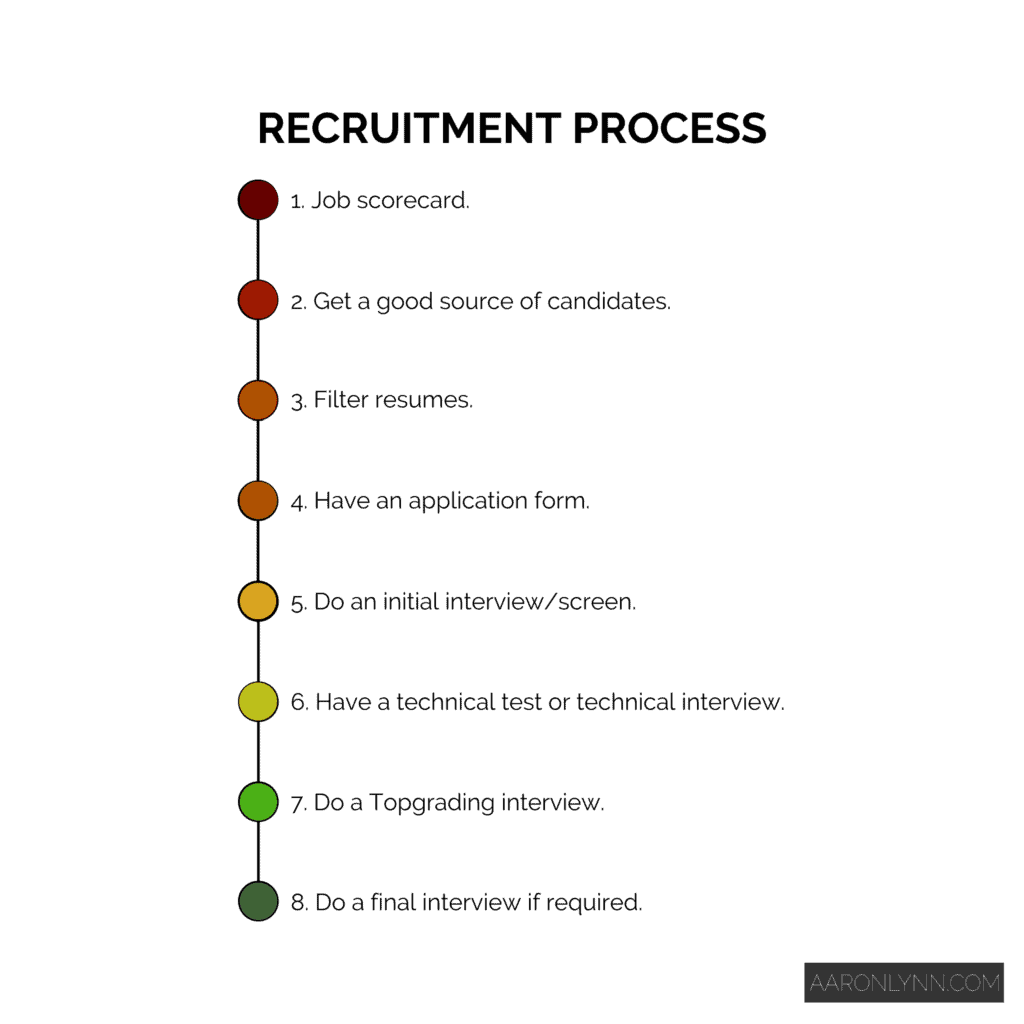
One of the most common problems in business is hiring new team members.
If you browse the financial headlines you’ll commonly see trends about people resigning, talent moving to higher paying jobs or people opting out of working altogether.
So as a small or medium-sized business owner, just how are you supposed to go about hiring new team members?
Here’s what I’ve learnt over the last 15+ years of hiring for my businesses and helping other business owners hire.
1. Get Your Hiring Mindset Right

Hiring for your business begins with your mindset as a business owner.
The most important thing is to realise that you must sell the idea of working with you just as much as the candidate has to sell themselves for the position.
Why?
Because if you’re hiring A-players or the best-of-the-best, you aren’t just competing against every other small business out there — you’re competing against tech giants and big brand name companies.
The best candidates really do have their pick of where to work, and because of this, you must be competitive in recruiting to bring them onboard.
If you hire Asia-based staff, you’ll also encounter the phenomenon of employees who want to spend a couple of years with you to get some experience on their resume, and then want to move on to a big brand name like Google or ByteDance for the status-brag.1If you want to find out more about this, follow Jonathan Pengel on LinkedIn. He’s the founder of Marketyze, an amazing digital marketing agency based in Bangkok.
As a business owner, you have to build selling how good it is to work with you into the recruitment process. You do this by being professional, by being punctual, by talking up the company on interviews and by having good recruitment marketing efforts.
You’ll also want to prepare yourself for the fact that professional ghosting is real.
If you’ve ever ventured into the world of online dating, well… recruitment is a bit like that nowadays.
Yes, candidates will up and disappear, not reply to emails, not turn up for interviews, or even not turn up for the first day of work with no explanation or further communication.
We’ve all become quite naughty in our personal lives,2Due to social media and its inflation of false status/popularity and feeding of the ego. and it has bled over into our professional lives.
There is a ton of silly nonsense going around, including:
- Candidates not wanting to fill in a basic application form.
- Candidates sending you past paycheques to show you how “good” they are.
- Candidates refusing to interview.
- Last-minute reschedules, no-shows and more.
This is all because there are relatively few consequences for bad behaviour when it comes to applying for work.3Can you imagine if we had a version of Glassdoor for candidates? 🤔
As a business owner, you have to make peace with this and realise that nothing is final until the candidate shows up for work and starts doing what they are supposed to do.
The next mindset shift you need to make is that the hiring ratios are really, really, bad nowadays… but that’s just part of the process.
It will look something like:
- 100 resumes.
- 10 candidates who can actually complete the application process.
- 3 candidates interviewed.
- 1 is hired.
This is normal across all industries now.
Underlying all of this is that you need a recruitment process, you can’t just improvise.
Having a process will stop you from going insane at the levels of BS present in recruitment nowadays.
It will also let you pass on the administrative side to an assistant or operations manager, and you can just check in on the interviews.
Don’t be the business owner who hires entirely based on gut-feel.4You’ll end up with people who are great at talking themselves up but have no real work ability.
Do be the business owner who talks to candidates at least once — it’s important!
2. Have a Good Recruitment Process for Hiring New Team Members
Here’s my recommended recruitment process for SME business owners:
- Job scorecard.
- Get a good source of candidates.
- Filter resumes.
- Have an application form.
- Do an initial interview/screen.
- Have a technical test or technical interview.
- Do a Topgrading interview.
- Do a final interview if required.
You may be asking — do I need to do all these steps?
No, especially if you are recruiting entry-level.
But I would recommend doing all of them for a senior hire.
A fast-track version would be:
- Automated initial screen via video/AI.
- Technical test.
- Final interview / vibe check.
Here’s why you need each step.
1. Job scorecard
A job scorecard or similar job description lets you define what you want as a business.
What do you need this person to actually do?
How will you know that they are actually doing it?
Work this out for your internal use.
Then turn it into a job ad.
Want a template for this? It’s something that I give to my True Business Owner clients!
2. Good source of candidates
A recruitment funnel is just like any other kind of marketing funnel, and you need a good source of leads (candidates).
This could be your network, a recruiter/headhunter or a sourcing firm.
You could also run your own ads on LinkedIn or Facebook.
3. Resume filtering
Resume filtering will be your initial screening of candidates.
Be prepared to discover just how much of a lost art the resume has become nowadays.
4. Application form
If you need some specific information that a standard resume doesn’t cover, ask candidates to send it in.
This could be a cover letter. Or it could be some short notes and Q&A about your industry.
5. Initial interview / screen
I like to screen candidates upfront, through a short video interview.
This is really a vibe check, to make sure that they’re a real person,5Yep 🙄. and that they are organised enough to make it to a Zoom call.
6. Technical test or interview
If the role you are hiring for is technical, then have a technical test or interview.
This should be indicative of the role’s KPIs and the work that the candidate will actually have to do if hired.
7. Topgrading interview
Topgrading interviews come from Bradford Smart’s classic book, Topgrading.
It is a long interview that goes through a candidate’s work history and asks the difficult questions like why they left a previous company or what they thought about their former managers.
My suggestion is to do this with two interviewers, and to watch for red flags, gaps in answers and questions that need to be asked.
Good, professional candidates who actually want the job will have no problem going through this interview process.
Candidates who are against it usually have something to hide.
And yes, there is a template for this inside True Business Owner.
8. Final interview
If needed, have a team member that the candidate will be working with do a final, short interview as a vibe check.
All this may seem overly manual, but there are new technologies like interviewer.ai and automated resume filtering that can help with this. I’ll update this guide as they become more accessible for businesses.
3. Sourcing Candidates

You need to be able to source good candidates if you want to hire good employees.
Where you source them from depends largely on the role you are hiring for.
Here is what I’ve seen.
The first place to look is your network.
Tap into your vendors, customers, past clients, friends, business school classmates and more.
Usually, the best candidates are where there is a personal connection or referral.
e.g., a past customer who is a raving fan who really wants to work with you.
The next place is headhunters or recruitment companies.
Headhunters maintain a professional network and find people.
Recruitment companies run ads or find people on LinkedIn and do the outreach for you and bring in candidates.
I’ll give a shoutout to two of my favourite recruitment companies here:
- Let’s Remotivate (for remote workers in the US/Europe).
- Gibas Associates (for VAs from the Philippines).
The last option is to run your own job ads, whether that’s on LinkedIn, Facebook or job boards. Only recommended if you know what you are doing!
All these sourcing options work, it just comes down to time and money.
4. Recruitment Marketing for Hiring New Team Members

Something not-often talked about when it comes to hiring is recruitment marketing.
This is the beginning stages of selling your company as a great place to work to potential candidates.
Some basics would include:
- A careers page on your website.
- A YouTube channel showing behind-the-scenes.
- Talking up your company to your network when appropriate.
- Good reviews on Glassdoor.
- Industry awards.
Having good recruitment marketing lets you build a virtual bench of people who like your company and may want to work with you when the opportunity arises.
5. Managing New Hires

How to onboard and manage new hires are articles in and of themselves.
I’ll make a brief mention here because turnover is a HUGE problem if you don’t manage your new hires properly.
At the very least, you must have:
- An onboarding process.
- Work for them to do.
An onboarding process is just the first set of meetings, work, and training that new hires go through when they start working with you. It could include:
- A welcome call from you / a senior team member.
- Basic training, your company core values and culture.
- HR how-tos like payslips, leave requests, introductions to the team.
- Role-specific training.
- Start work and projects to move them into everyday work.
You must make your new hires feel welcome — don’t put them through a trial by fire.
And yes, more senior/experienced hires are expected to get themselves up and running faster and that’s fine — but onboarding is always nice and appreciated.
There is a lot to cover when it comes to recruiting and hiring new team members.
Consider this article an outline of the big thing you need to look out for — and keep an eye out for more detailed guides to come.
- If you want to find out more about this, follow Jonathan Pengel on LinkedIn. He’s the founder of Marketyze, an amazing digital marketing agency based in Bangkok.
- Due to social media and its inflation of false status/popularity and feeding of the ego.
- Can you imagine if we had a version of Glassdoor for candidates? 🤔
- You’ll end up with people who are great at talking themselves up but have no real work ability.
- Yep 🙄.
